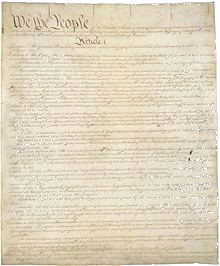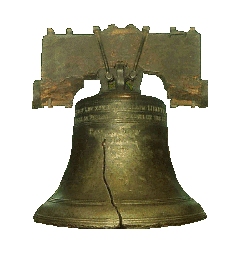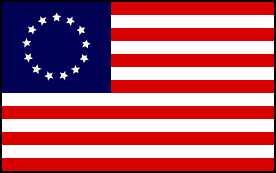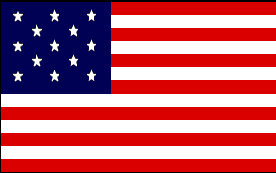Of the United States of America
We the people...
Can
You Pass the Citizenship Test?
Take it
HERE
Liberty
1776
The Constitution is venerable. The Constitution is the blueprint of America, defining it's purpose and obligations, and the specific rules and boundaries for the government of the people.
The first 52 words of the Constitution, the Preamble, lists six objectives and purposes of the government, followed by seven articles describing the organization, obligations, and limits of the government. The first ten ammendments, collectively known as the Bill of Rights, ratified concurrently with the Constitution itself, are an integral part of the document.
The constitutions of some countries are changed and ammended regularly, many times under suspicious circumstances, and for nefarious motives. The Constitution of the United States has not substantially changed in over 200 years of the Republic. In addition to the first ten ammendments, there have been only seventeen additional ammendments passed over these many years. Over 10,000 ammendments have been proposed, but only seventeen have actually passed and become the law of the land.
All this, and the Constitution itself did not pass ratification with overwhelming results. Only three colonies (states) ratifed the document with a 100% yay vote. Several states ratified the passage with the slimmest margin. But, pass it did and has been the law of the land ever since. It is held in high regard by people around the world, and has served as a model for the constitutions of many, many other countries.

The Preamble
We the People of the United States, in Order to form a more perfect Union, establish Justice, insure domestic Tranquility, provide for the common defence, promote the general Welfare, and secure the Blessings of Liberty to ourselves and our Posterity, do ordain and establish this Constitution for the United States of America.
The Seven Articles
Article I - The Legislative Branch
Article II - The Executive Branch
Article III - The Judicial Branch
Article IV - The States Powers and Limits
Article V - Procedures for Ammendments
Article VI - Federal Powers
Atticle VII - Rules for Ratification
The Bill of Rights
Ammendment 1 - Freedom of Religion, Press, Expression
Ammendment 2 - Right to Bear Arms
Ammendment 3 - Ouartering of Soldiers
Ammendment 4 - Search and Seizure
Ammendment 5 - Trial and Punishment
Ammendment 6 - Right to Speedy Trial
Ammendment 7 - Trial by Jury
Ammendment 8 - Cruel and Unusual Punishment
Ammendment 9 - Unspecified Rights
Ammendment 10 - Powers of the States and People
The Ratification VOTE
The Ammendments
Delaware
30
0
Pennsylvania
46
23
New Jersey
38
0
Georgia
26
0
Connecticut
128
40
Massachusettes
187
168
Maryland
63
11
South Carolina
149
73
New Hampshire
57
47
Virgina
89
79
New York
30
27
North Carolina
194
77
Rhode Island
34
32
This website was created and is maintained by:
Philip J. June
Tucson, AZ
This website was first created
and published on 12.08.07;
Last update was 12.08.07
Constitution LINKS:
The text of the Constitution here:
Other Historical American Documents:
Interactive
historical displays, multimedia:
*
*
(With this state's signing, the Constitution became legal)
People sometimes forget that the founding fathers had one hundred plus years of colonial history under their belts when they gathered to write the Constitution. This experience greatly affected their thinking. They certainly didn’t like everything they saw in the colonies. Some of the same mistakes made in the old country were being repeated here.
They took this experience, along with ideas from classical antiquity, and the British tradition of mixed government, and their Bill of Rights, added in some writings from John Locke and out of that mix came the Constitution of the United States.
As venerable as we regard the Constitution today, at the time of it’s ratification it was not an overwhelming success. More than one state passed it only with the provision that the Bill of Rights be added. Only 39 of the 42 assembled delegates actually voted on passage, and no one was completely satisfied. Rhode Island didn’t even show up. In fact, some of the same arguments the founders were having are still being argued today, two hundred years later.
The colonies were, for most of their 100 plus years, operating under the Articles of Confederation, the original document uniting the colonies. There were many problems with the Articles, which the founders hoped to fix with the new Constitution. Under the Articles of Confederation the colonies were essentially separate, independent states loosely tied to a virtually non-existent central government. This was unworkable as it did nothing to facilitate commerce among the states, nor did it provide a way of paying for the government. The central government was very weak and had no power to raise an army, make treaties, declare war, or collect taxes. It had no control over foreign commerce and had no power to force states to carry out its measures.
And so on February 21, 1787 Congress resolved to call a Convention for the sole purpose of revising the Articles of Confederation. On May 25, 1787, the delegates met in Philadelphia and began their deliberations.
There were many, many arguments and numerous compromises. One of the biggest arguments was the division of power between the states and the federal government, the so-called “States Rights” question. This argument is still going on today.
After months of conflicting views, heated debates and clashing ideas, the delegates completed the document on September 17, 1787, after which it was sent to the thirteen colonies for ratification. Under the rules of ratification, the Constitution would be ratified when 9 of the 13 colonies passed it. That was done on June 21, 1788 when New Hampshire voted for passage by a vote of 57 to 47. On March 4, 1789 the United States Constitution took effect and has been the law of the land ever since.
A Brief History
Important Dates:
February 21, 1787
Congress calls for Constitutional Convention
May 25, 1787
Delegates meet in Philadelphia
September 17, 1787
Constitution is finished and sent out for ratification
June 21, 1788
New Hampshire passes and thereby ratifies the Constitution
March 4, 1789
Constitution takes effect and new government takes over
Ammendment 11 - Judicial Limits
Ammendment 12 - Choosing the President/ Vice President
Ammendment 13 - Slavery Abolished
Ammendment 14 - Citizenship Rights
Ammendment 15 - Voting Rights not denied due to race/color
Ammendment 16 - Income Tax
Ammendment 17 - Direct Election of Senators
Ammendment 18 - Prohibition of Liquor
Ammendment 19 - Women's Suffrage
Ammendment 20 - President and Congress Terms
Ammendment 21 - Repeals Prohibition (18th Ammendment)
Ammendment 22 - Term Limits for President
Ammendment 23 - Presidential Vote for District of Columbia
Ammendment 24 - Poll Taxes Barred
Ammendment 25 - Presidential Disabiltity and Succession
Ammendment 26 - Voting age lowered to 18
Ammendment 27 - Limits Congressional Pay Raises




































